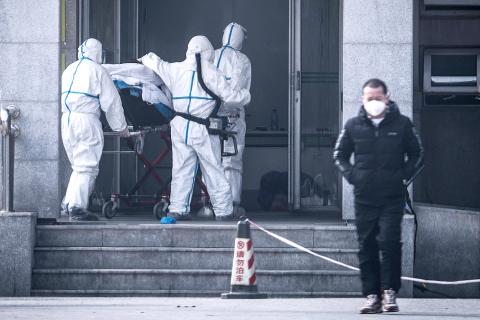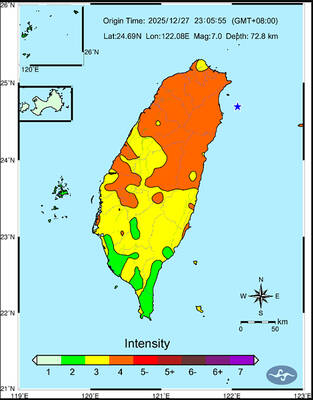The true scale of a viral pneumonia outbreak in China is likely far bigger than officially reported, scientists have said, as countries ramp up measures to prevent the disease from spreading.
Fears that the virus will spread are growing ahead of the Lunar New Year holiday, when hundreds of millions of Chinese move around the country and many others host or visit extended family members living overseas.
Authorities in China have said two people have died and at least 45 have been infected, with the outbreak centered around a seafood market in Wuhan, a central city of 11 million inhabitants that serves as a major transport hub.

Photo: AFP
However, a paper published Friday by scientists with the MRC Centre for Global Infectious Disease Analysis at Imperial College in London said that the number of cases in the city was likely about 1,700.
The researchers said that their estimate was largely based on the fact that cases had been reported overseas — two in Thailand and one in Japan.
The virus — a new strain of coronavirus that humans can contract — has caused alarm because of its connection to SARS, which killed nearly 650 people across China and Hong Kong in 2002-2003.
China has not announced any travel restrictions, but authorities in Hong Kong have stepped up detection measures, including rigorous temperature checkpoints for inbound travelers from China.
The US has said that from Friday it would begin screening flights arriving from Wuhan at San Francisco International Airport and New York’s John F. Kennedy International Airport — which both receive direct flights — as well as Los Angeles International Airport, where many flights connect.
Thailand said it was already screening passengers arriving in Bangkok, Chiang Mai and Phuket, and would soon introduce similar controls in Krabi.
No human-to-human transmission has been confirmed so far, but the Wuhan Municipal Health Commission has said that the possibility “cannot be excluded.”
A WHO doctor said it would not be surprising if there was “some limited human-to-human transmission, especially among families who have close contact with one another.”
Scientists with the MRC Centre for Global Infectious Disease Analysis — which advises bodies including the WHO — said they estimated a “total of 1,723” people in Wuhan would have been infected as of Sunday last week.
“For Wuhan to have exported three cases to other countries would imply there would have to be many more cases than have been reported,” Neil Ferguson, one of the authors of the report, told the BBC.
“I am substantially more concerned than I was a week ago,” he said, while adding that it was “too early to be alarmist.”
“People should be considering the possibility of substantial human-to-human transmission more seriously than they have so far,” he said, adding that it was “unlikely” that animal exposure was the sole source of infection.
Local authorities in Wuhan said a 69-year-old man died on Wednesday, becoming the second fatality, with the disease causing pulmonary tuberculosis and damage to multiple organ functions.
After the death was reported, online discussion spread in China over the severity of the coronavirus — and how much information the government might be hiding from the public.
Several complained about censorship of online posts, while others made comparisons to 2003, when Beijing drew criticism from the WHO for underreporting the number of SARS cases.
“It’s so strange,” wrote a Web user on Sina Weibo, citing the overseas cases in Japan and Thailand. “They all have Wuhan pneumonia cases but [in China] we don’t have any infections outside of Wuhan — is that scientific?”

A magnitude 7.0 earthquake struck off Yilan at 11:05pm yesterday, the Central Weather Administration (CWA) said. The epicenter was located at sea, about 32.3km east of Yilan County Hall, at a depth of 72.8km, CWA data showed There were no immediate reports of damage. The intensity of the quake, which gauges the actual effect of a seismic event, measured 4 in Yilan County area on Taiwan’s seven-tier intensity scale, the data showed. It measured 4 in other parts of eastern, northern and central Taiwan as well as Tainan, and 3 in Kaohsiung and Pingtung County, and 2 in Lienchiang and Penghu counties and 1

FOREIGN INTERFERENCE: Beijing would likely intensify public opinion warfare in next year’s local elections to prevent Lai from getting re-elected, the ‘Yomiuri Shimbun’ said Internal documents from a Chinese artificial intelligence (AI) company indicated that China has been using the technology to intervene in foreign elections, including propaganda targeting Taiwan’s local elections next year and presidential elections in 2028, a Japanese newspaper reported yesterday. The Institute of National Security of Vanderbilt University obtained nearly 400 pages of documents from GoLaxy, a company with ties to the Chinese government, and found evidence that it had apparently deployed sophisticated, AI-driven propaganda campaigns in Hong Kong and Taiwan to shape public opinion, the Yomiuri Shimbun reported. GoLaxy provides insights, situation analysis and public opinion-shaping technology by conducting network surveillance

Taiwan is gearing up to celebrate the New Year at events across the country, headlined by the annual countdown and Taipei 101 fireworks display at midnight. Many of the events are to be livesteamed online. See below for lineups and links: Taipei Taipei’s New Year’s Party 2026 is to begin at 7pm and run until 1am, with the theme “Sailing to the Future.” South Korean girl group KARA is headlining the concert at Taipei City Hall Plaza, with additional performances by Amber An (安心亞), Nick Chou (周湯豪), hip-hop trio Nine One One (玖壹壹), Bii (畢書盡), girl group Genblue (幻藍小熊) and more. The festivities are to

AFTERMATH: The Taipei City Government said it received 39 minor incident reports including gas leaks, water leaks and outages, and a damaged traffic signal A magnitude 7.0 earthquake struck off Taiwan’s northeastern coast late on Saturday, producing only two major aftershocks as of yesterday noon, the Central Weather Administration (CWA) said. The limited aftershocks contrast with last year’s major earthquake in Hualien County, as Saturday’s earthquake occurred at a greater depth in a subduction zone. Saturday’s earthquake struck at 11:05pm, with its hypocenter about 32.3km east of Yilan County Hall, at a depth of 72.8km. Shaking was felt in 17 administrative regions north of Tainan and in eastern Taiwan, reaching intensity level 4 on Taiwan’s seven-tier seismic scale, the CWA said. In Hualien, the